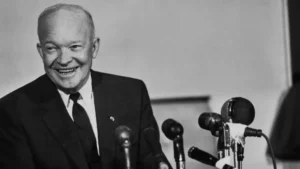Eisenhower said ‘Every gun that is made’ signifies ‘a theft from those who hunger and are not fed’?

In mid-June 2025, a rumour circulated on Facebook claiming former U.S. President Dwight D. Eisenhower once said, “Every gun that is made, every warship launched, every rocket fired signifies, in the final sense, a theft from those who hunger and are not fed, those who are cold and are not clothed.”
For example, Robert Reich, former United States Secretary of Labor, posted the quote on his Facebook page, receiving over 80,000 reactions within two days. Two other Facebook posts attributed the quote to Eisenhower.
Historical records confirm that Eisenhower delivered this statement during a presidential address and primary sources document the quote’s authenticity. As a result, we’ve rated the attribution correct.
Eisenhower delivered the quote during his “Chance for Peace” speech, also known as the “Cross of Iron” speech, before the American Society of Newspaper Editors on April 16, 1953. The address came after the death of Soviet leader Josef Stalin, as Eisenhower sought to present an alternative to the Cold War arms race.
The website of the Miller Center, a nonpartisan institution at the University of Virginia, hosted audio of the full speech. The quote in question appears starting around the 11:17 mark.
The American Presidency Project also hosted transcripts of Eisenhower’s address. The Eisenhower Presidential Library listed the quote as authentic and also hosted audio of Eisenhower saying the quote in question.
Eisenhower delivered the speech from the Statler Hotel in Washington, D.C., and television and radio broadcast it nationwide. In the speech, Eisenhower presented a choice between military buildup and investment in human welfare.
The passage containing the quote read (emphasis ours):
Every gun that is made, every warship launched, every rocket fired signifies, in the final sense, a theft from those who hunger and are not fed, those who are cold and are not clothed. This world in arms is not spending money alone. It is spending the sweat of its laborers, the genius of its scientists, the hopes of its children.
Eisenhower continued by suggesting different things the money used on weapons could pay for:
The cost of one modern heavy bomber is this: a modern brick school in more than 30 cities. It is two electric power plants, each serving a town of 60,000 population. It is two fine, fully equipped hospitals. It is some 50 miles of concrete highway. We pay for a single fighter plane with a half million bushels of wheat. We pay for a single destroyer with new homes that could have housed more than 8,000 people.
He concluded this section by stating: “This is not a way of life at all, in any true sense. Under the cloud of threatening war, it is humanity hanging from a cross of iron.”
Despite the hopes Eisenhower expressed in the “Chance for Peace” speech, the Cold War continued to intensify during his presidency. By the time he left office in 1961, he felt compelled to deliver another warning about the “military-industrial complex” in his farewell address — a speech that bookended his presidency’s concerns about militarization.